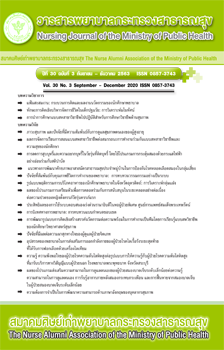Reduction of Smoking and Cigarette Craving in Adolescents with Smoking Addiction using Transcranial Direct Current Stimulation Integrated with Mindfulness Based Therapy Programs
Main Article Content
Abstract
The objective of this research was to study the effect of transcranial direct current stimulation with mindfulness-based therapy programs for reducing smoking and cigarette craving in smoking addiction adolescents. The participants were thirty adolescents addicted to smoking from secondary school in Chonburi province. The research design used was a one group pretest and posttest design. Research instruments included 1) Questionnaire of Smoking Urges, 2) Breathalyzer carbon monoxide level monitor, and 3) Urine nicotine kit. The 5-day transcranial direct current stimulation with mindfulness-based therapy programs consisted of 2 activities; 1) 30-minute mindfulness activities, and 2) brain stimulation using 20-minute mild electrical current. Data were analyzed by using descriptive statistics and dependent t-tests. It was found that after the experiment, the mean scores of cigarette craving, breath carbon monoxide (BCO), nicotine level in urine and the mean number of cigarettes smoked exhibited a significant decrease when compared to the before-experiment condition. It can be concluded that transcranial direct current stimulation with mindfulness-based therapy programs can be used as an alternative method for reducing the smoking and cigarette craving in smoking adolescents.
Article Details
บทความและรายงานวิจัยในวารสารพยาบาลกระทรวงสาธารณสุข เป็นความคิดเห็นของ ผู้เขียน มิใช่ของคณะผู้จัดทำ และมิใช่ความรับผิดชอบของสมาคมศิษย์เก่าพยาบาลกระทรวงสาธารณสุข ซึ่งสามารถนำไปอ้างอิงได้
References
2. Pitayarangsarit S, Chotibenjamaporn P, Pankrajang P. (Eds). A situation of tobacco control in Thailand 2016. Bangkok: CharoendeeMunkong Publishing;2016. (in Thai).
3. Pitayarangsarit S, Pankrajang P. (Eds). A report on tobacco consumption in Thailand 2018. Bangkok: Charoendee Munkong Publishing;2018. (in Thai).
4. National Statistical Office. Presentation of data from a survey smoking and alcohol drinking in 2017. Bangkok: Pimdeekarnpim Publishing;2018. (in Thai).
5. Bundhamcharoen K, Aungkulanon S, Makka N, Shibuya K. Economic burden from smoking-related diseases in Thailand. Tobacco Control. 2015;25(5):532-7. doi.10.1136/tobaccocontrol-2015-052319. PubMed PMID:26427527.
6. Batsikadze G, Paulus W, Hasan A, Grundey J, Kuo MF, Nitsche MA, et al. Compromised neuroplasticity in cigarette smokers under nicotine withdrawal is restituted by the nicotinic α 4 β 2-receptor partial agonist varenicline. Scientific Reports.2017;7:1-11.
7. Durkin S, Bayly M, Brennan M, Biener L, Wakefield M. Fear, sadness and hope: which emotions maximize impact of anti-tobacco mass media advertisements among lower and higher SES groups?. Journal of health communication.2018;445-61.
8. Kazemzadeh Z, Manzari Z, Pouresmail Z. Nursing interventions for smoking cessation in hospitalized patients: a systematic review. Int Nurs Rev.2017;64(2):263-75.doi:10.1111/inr.12320.
9. Marine M, David L, Stéphanie G, Dominique J, Marie FS, Emmanuel P, et al. Effects of repeated transcranial direct current stimulation on smoking, craving and brain reactivity to smoking cues. Scientific Reports.2018;1-11.
10. Bevan E. The effect of mindfulness training on drug craving is moderated by level of negative affect. [Dissertation]. Scranton (PA): Marywood University;2010.
11. Andreu CL, Cosmelli D, Slagter HA, Franken IH. Effects of a brief mindfulness-meditation intervention on neural measures of response inhibition in cigarette smokers. PloS one.2018;1-16.
12. Trangkasombat U, Lap Bunsap W, Havanont P. Use of CES-D in the screening of depression among adolescents. Journal of the Psychiatric Association of Thailand.2009;42(1):2-13. (in Thai)
13. Watee Sathokkit K. Promotion of smoking cessation in routine work Bangkok: Foundation for Do not smoke;2009. (in Thai).
14. Cox LS, Tiffany ST, Christen AG. Evaluation of the brief questionnaire of smoking urges (QSU-brief) in laboratory and clinical settings. Nicotine & Tobacco Research.2001;3(1):7-16.
15. Phanom Ketman. Group counseling. Featured in: the doctor’s handbook of post-dangerous mental disorders post-traumatic stress disorder. Samut Prakan: Pre Team Marketing;2005 (in Thai).
16. Falcone M, Bernado L, Ashare RL, Hamilton RH , Olufunsho KF, McKee SA, et al. Transcranial direct current brain stimulation increases ability to resist smoking. Brain stimulation. 2016;9(2):191-6.
17. Yang LZ , Shi B, Li H, Zhang W, Liu Y, Wang H, et al. .Electrical stimulation reduces smokers’ craving by modulating the coupling between dorsal lateral prefrontal cortex and parahippocampal gyrus. Social Cognitive and Affective Neuroscience.2017;12(8):1296-302.
18. Falcone M, Bernardo L, Wileyto EP, Allenby CE, BurkeAM, Hamilton RH, et al. Lack of effect of transcranial direct current stimulation (tDCS) on short-term smoking cessation: results of a randomized, sham-controlled clinical trial. Drug Alcohol Depend.2019;1(194):244-51.doi:10.1016/j.drugalcdep.2018.10.016. PubMed PMID:30497056.
19. Garrison K A, Prasanta P, Rojiani R, Dallery J, O’Malley SS, Brewer JA, et al. A randomized controlled trial of smartphone-based mindfulness training for smoking cessation: a study protocol. BMC psychiatry. 2015;14(15):83-90.

